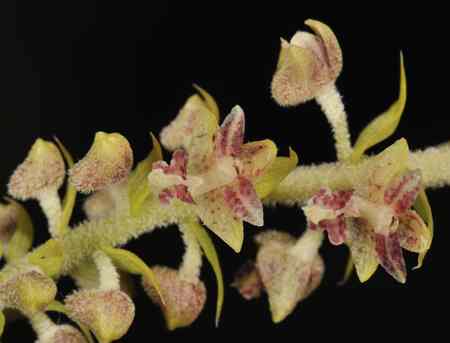Epiphyte. Stems 2 to 3 ft long and about 1.5 cm in diameter. Leaves many, fleshy, linear, sessile, 2 to 3 cm long and hardly 1 cm in width. Racemes in terminal fascicles, 2 to 3 in numbers, sometimes even up to 5, 5 to 12 cm long, woolly with lanceolate bracts at their bases. Flowers around 1 cm across, translucent, petals and sepals and the lip is of a pale yellowish green base. Petals and base of the lip with broad purple shade and deep blotches of the same colour, except on the midrib portion and edges of the petals and on the callus of the lip. Sepals with irregular pale purple markings. Dorsal sepal ovate and the lateral pair more towards a triangular shape, spreading. Petals as long as the dorsal sepal, obovate. The lip is sub-orbicular, 3 lobed, the base with a large callus, lateral lobes oblong, sub-falcate. All parts are pubescent externally.

The Pursuit
This species can be found growing in the tropical forests of the region. However, the find of this specimen was accidental. It was in the late days of winter and I was on a trip to locate some other plants. The survey was in a valley which is a tributary of the river Teesta, at low elevation. I have to climb down from 4800 ft to the valley. As there was a village in the valley the trek path was regularly used by villagers. As it was the early spring month the undergrowth on the valley was also moderate. Hence I was searching for some terrestrial orchids in the valley. As the schools of the region are yet to open after the winter vacations, a few kids of the village also joined me. As they know me and my work, they also joined the search operation for the ground orchids. After a couple of hours of search and survey, we all were crossing the tributary through a wooden bridge. All of a sudden one of the boys spotted this plant, a pendulous stem about 2 ft long with flowers on a tree next to the bridge. I was surprised to see it in flowers too. The enthusiastic boys were ready to pull the plant down for me. It has always been my policy not to remove the plants from its natural habitats. The plant was hardly 12 to 15 ft high on the tree. My companions were expert enough to climb up the tree before me. This valley of the region is always devoid of any wind or breeze, which makes it very much comfortable to shoot even pendulous plants. With the help of the three kids I produced this wonderful photograph. After that I came across this species in flower many times for the next 2 to 3 months from several locations also.